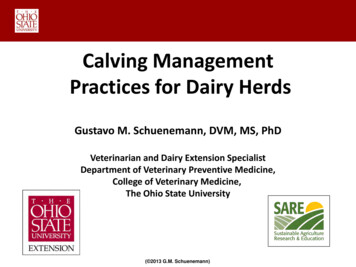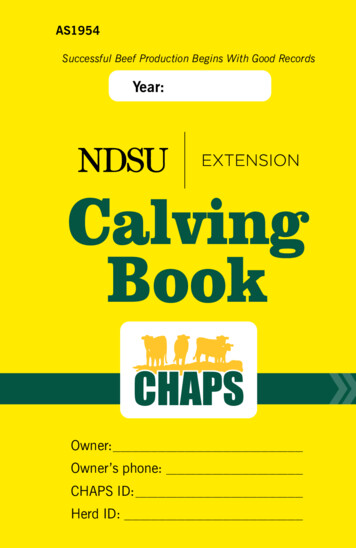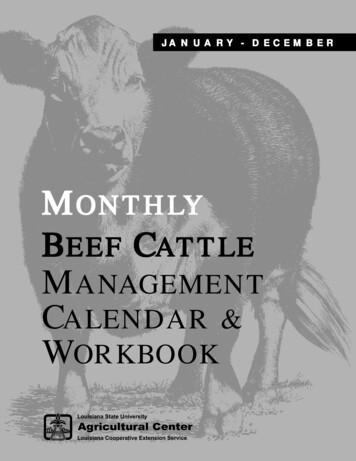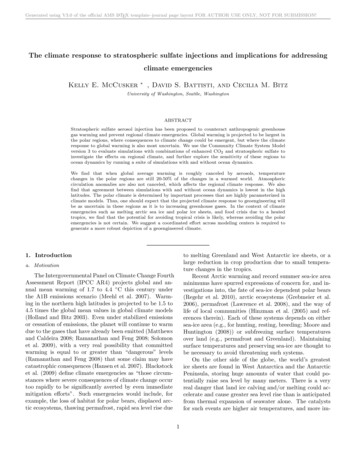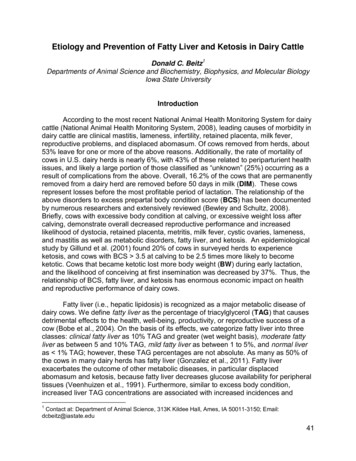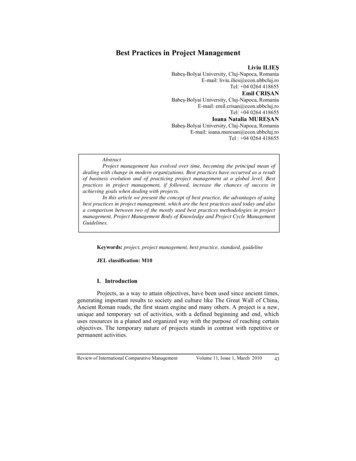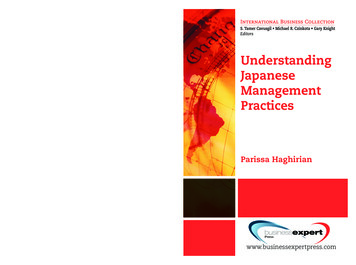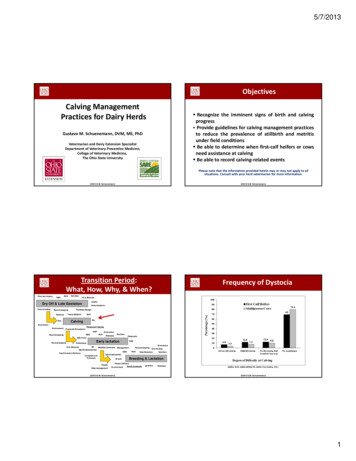
Transcription
5/7/2013ObjectivesCalving ManagementPractices for Dairy Herds Recognize the imminent signs of birth and calvingprogress Provide guidelines for calving management practicesto reduce the prevalence of stillbirth and metritisunder field conditions Be able to determine when first‐calf heifers or cowsneed assistance at calving Be able to record calving‐related eventsGustavo M. Schuenemann, DVM, MS, PhDVeterinarian and Dairy Extension SpecialistDepartment of Veterinary Preventive Medicine,College of Veterinary Medicine,The Ohio State UniversityPlease note that the information provided herein may or may not apply to allsituations. Consult with your herd veterinarian for more information.( 2013 G.M. Schuenemann)( 2013 G.M. Schuenemann)Transition Period:What, How, Why, & When?Prior lact historyTMRBCSNutritionVit & MineralsHealthDry Off & Late cy of l TrainingT i ingNutritionDiseasesDiagnosisMilk FeverRecord-keepingDA/KetosisEarly lactationRPVit & onomicsManagementNEBFeed Inventory/DeliveryCompliance toProtocolsRecord-keepingBCSSire FertilityHeat DetectionNutritionSub-EndometritisAI techPeopleData managementBreeding & LactationSemen DeliverySynch protocolsEnvironment( 2013 G.M. Schuenemann)geneticsDiseases(USDA. 2010. USDA:APHIS:VS, CEAH. Fort Collins, CO.)( 2013 G.M. Schuenemann)1
5/7/2013Maternity Pen or AreaSizing the Close‐Up Pen Example: 2000‐cow herd Determine the time period (3 wks) and size ofclose‐up pen (# of stalls)‐ 2000/365 average 5.5 births per day Guidelines:‐ At least 175 ft2 (16 m2) per cow‐ Flooring: sand, dirt, or clay‐ Bedding: straw (6‐10 in deep)deep), changefrequently to keep it dry and clean‐ Well‐ventilated‐ Adequate lighting How many calving per week?‐5.5 births/d * 7 d 38 births per week How long is the close‐up period?‐ 38 births * 3 wks 115 births for the 3‐wkclose‐up period( 2013 G.M. Schuenemann)( 2013 G.M. Schuenemann)Sizing the Close‐Up PenManagement of Close‐Up Cows60 Although “average” births per week is avaluable metric, most producers are facedwith calving “ranges”5455Numbeer of Births5045403538 births All these calculations assume cow grouping atdry‐off and “calving date” is known30252015105Average 38 births per weekRange 6-54 (or 16% - 142% of weekly average)Guideline: to avoid overstocking, plan for 162 stalls for the close-up periodbased on max average (140%) births per week (54 births/wk * 3 wks 162 stalls)0( 2013 G.M. Schuenemann)6 Add additional challenges for no‐calving dates(bull bred first‐calf heifers or cow, missingrecords, or unknown pregnancy status)( 2013 G.M. Schuenemann)2
5/7/2013Parturition Parturition is a process initiated by a cascadeof hormonal and physical changes at the endof gestation ( 280 days in cattle) Three stages:‐ Stage I (dilation of birth canal)‐ Stage II (labor or calf expulsion)‐ Stage III (passing fetal membranes) It progresses gradually from one stage to thenext!(Noakes et al., 2001; Schuenemann et al., 2013)Stage I Stage I consists of the dilation of the birthcanal (soft tissues and ligaments) Restless behavior: Walk, transition from layingto standing positions, kick the belly,vocalization, tail raised, urinate, Physical changes: Udder is full, dilation ofvulvar ring, It ends with a fully dilated cervix and theappearance of the amniotic sac (AS) or “waterbag” outside the vulva( 2013 G.M. Schuenemann)( 2013 G.M. Schuenemann)Stage II Stage II begins with a fully dilated cervix, theappearance of the “water bag”, andabdominal contractions are evidentStrainingDelivery( 2013 G.M. Schuenemann)( 2013 G.M. Schuenemann)3
5/7/2013Stage III Stage III is the expulsion of the fetalmembranes, which occurs around 8‐12 hourspost calving. If 24 hours, it is consideredretained fetal membranes(Kelton et al., 1998)Calf Delivery Presentation: It refers to whether the calf iscoming forward (anterior), backward(posterior), or transverse Position: It refers to the calf’s position inrelation to the cow Posture: It refers to how the calf’s head andlimbs are in relation with its body(Noakes et al., 2001; Schuenemann et al., 2013)( 2013 G.M. Schuenemann)Normal Calf DeliveryForward or AnteriorBackward or Posterior( 2013 G.M. Schuenemann)Eutocic or Dystocic Births Eutocic Birth: Normal delivery of single ormultiple calves Dystocic Birth: It is defined as a difficult birthresulting in prolonged calving or severeassisted extraction of the calf at birthEstimated values: Forward or Anterior 96% Backward or Posterior 4% Multiple Births 5% Breech 1%(Hunter et al., 2013)( 2013 G.M. Schuenemann)( 2013 G.M. Schuenemann)4
5/7/2013Early Signs of CalvingCow with enlarged vulva &mucus plugCow with dilated vulva &enlarged udder( 2013 G.M. Schuenemann)Imminent Signs of BirthEnvelops outside the vulva &tail‐raisedShowing feet/nose of the calfoutside the vulva( 2013 G.M. Schuenemann)Imminent Signs of CalvingWalking, pacing, sniffing,& tail‐raisedLying down & showing feet of thecalf outside the vulva( 2013 G.M. Schuenemann)Normal DeliveryThe rear legs of the calf are stillin the vulva of the cow, butbirth is completedCow recovers from labor, stand‐up, & lick the calf( 2013 G.M. Schuenemann)5
5/7/2013Cows: Calving Progress forUnassisted BirthsFirst‐Calf Heifers: Calving Progress forUnassisted Births(Schuenemann et al., 2011 JDS 94:5494–5501)(Schuenemann et al., 2011 JDS 94:5494–5501)( 2013 G.M. Schuenemann)( 2013 G.M. Schuenemann)First‐Calf Heifers: Calving Progress forAssisted BirthsReference Signs and Values forHolstein Cattle(Schuenemann et al., 2011 JDS 94:5494–5501)Signs of Normal BirthsDescriptionAppearance of the AS or feet of the calf outside thevulvaLandmark referencesNoakes et al., 2001Schuenemann et al., 2011aSigns of calving progressEvident every 1515‐2020minutesSchuenemann et al., 2011aMean time since the appearance of the AS outsidethe vulva to birth70 minutes(*)Noakes et al., 2001Schuenemann et al., 2011aMean time since the appearance of the feet of thecalf outside the vulva to birth65 minutes(*)Schuenemann et al., 2011a 2 hoursGundelach et al., 2009Schuenemann et al., 2011aAt least every 1 hourSchuenemann et al., 2011aTime that a cow or first‐calf heifer is in labor(abdominal contractions)Frequency of observationReferences(*) The mean times were estimated using the mean 2 SD (standard deviation)( 2013 G.M. Schuenemann)( 2013 G.M. Schuenemann)6
5/7/2013Length of Time in Maternity PenCow Move into Maternity Pen1200N 3,988 birthsRange: 10 min to 23 hAverage: 1.95 hMedian: 1.67 h100080060040020001234567 8Calving Duration (h)( 2013 G.M. Schuenemann)Landmarks of Imminent BirthAppearance of the “water bag”outside the vulva1400Number of Births Limited research studies on cowmove around parturition vsstillbirth For herds that group cowsaccording to expected calvingdate, periparturient cows shouldbe moved from close‐up tomaternity pen prior to or at theonset of labor (appearance of ASoutside the vulva) Frequency of observation andpersonnel skillsCow showing “water bag”outside the vulva (Stage II oronset of labor)( 2013 G.M. Schuenemann)Is the Calf Coming Backward?Appearance of the feet of thecalf outside the vulva Both rear legs or front legs? Will the calf fit into the birth canal? Monitor progress! ( 2013 G.M. Schuenemann)( 2013 G.M. Schuenemann)7
5/7/2013Monitor Calving ProgressGuidelines for Assisted BirthsOBSERVATIONAppearance of the “water bag”Parturition BeginsNormal BirthNo CalvingProgressShowing feet/nose of the calfINTERVENTIONDECISIONSNormal presentation,position, and postureAbnormal presentation,position, and postureCorrectionGuidelines forAssisted ExtractionBirth is completedCow is sniffing the newborn calfExtractionPossibleCalfAlive/DeadExtractionNot PossibleCalfAlive/DeadAssisted ExtractionNo Progresswithin 30 minCall Your Veterinarian(Adapted from Schuijt and Ball, 1980)( 2013 G.M. Schuenemann)Guidelines for ObstetricsLink: http://www.drostproject.org/en bovrep/guide.html Visual guide of calving management Calving supplies Abnormal postures or presentations Calving injuries ( 2013 G.M. Schuenemann)( 2013 G.M. Schuenemann)Hygiene Practices Use clean, disposable, long sleeve gloves Wash the perineum with clean water and soap‐disinfectant, repeatif cow defecates! Sanitize obstetric chains before and after each intervention or use( 2013 G.M. Schuenemann)8
5/7/2013Most Transition Diseases are Associated with Excessive NegativeNutrient/Calcium Balance and Body Tissue Mobilization Prior to- or after CalvingAssessing hygiene score at calving: Pictureshows an score 1(Adapted from Schreiner and Ruegg 2003; JDS 86:3460–3465)Score 1: Perineum region isfree of dirt/manure( 2% of surface area) Complete dryScore 2:Score 3: Manure/dirt is visiblearound the perineumregion 10% of surfacearea Perineum region ismoderately coveredwith dirt/manure 11-30% of surface(or greater)( 2013 G.M. Schuenemann)( 2013 G.M. Schuenemann)( 2013 G.M. Schuenemann)OSU Veterinary ExtensionGustavo M. Schuenemann, DVM, MS,PhD( 2013 G.M. Schuenemann)9
5/7/2013Effect of Hygiene Scores on MetritisWhen Should I Call for Help?(Adjusted by RFM, herd, stillbirth, parity, and calving difficulty)40Risk for Mettritis (%)35(a,bP 0.05)30a25a2015b105(n 301)(n 117)(n 84)Score 1Score 2Score 30 Establish guidelines in your SOP Normal progression occurs every 15‐20 minutes If no progress within 1 hour after the appearance of thewater bag, intervention is required! WhenWh abnormalbl posturetisi evidentid t (e.g.,(appearance off onefoot outside the vulva) immediately after “water bag”appearance, or for uterine torsions (where the water bag orfeet do not appear outside the vulva), obstetric interventionis rendered If there is no progress within 30 minutes of intervention, callfor help!Hygiene Scores at Birth(Schuenemann et al., 2011b; JDS 94:744)( 2013 G.M. Schuenemann)Calving‐Related Injury( 2013 G.M. Schuenemann)Assist the Newborn Make sure the calf isbreathing Check cow for anyadditional calf (twins) Feed colostrum to the calfwithin 3 hours of birth When the cow is able tostand and walk, move herto the fresh penCow sniffing the newborn calfimmediately after birthVulvar or Perineal Laceration( 2013 G.M. Schuenemann)( 2013 G.M. Schuenemann)10
5/7/2013Link to the Center for Food Security & Public Health at Iowa State University:http://www.cfsph.iastate.edu/Infection hpProper Sanitation Remove placenta from thematernity pen For assisted births, washand sanitize obstetricchains and bucket beforeand after each use See link to CFSPH below forselected desinfectantsLink to the Center for Food Security & Public Health at Iowa State University:http://www.cfsph.iastate.edu/Infection hp( 2013 G.M. Schuenemann)( 2013 G.M. Schuenemann)Serum Ca2 within 48 h after CalvingPrevention of Stillbirth At national level:‐ Selection program for sires with calving ease genetics At herd level:(Adapted from Reinhardt et al., 2011; Veterinary J. 188:122–124)( 2013 G.M. Schuenemann)‐‐‐‐‐‐‐‐Training of calving personnel & establish SOPsFacilities & prevent hypocalcemia prepartumClose monitoring of first‐calf heifersCalves born in backward presentationsCommunication at the time of shift change of personnelLength of time in dry penUse of sires with calving ease genetics ( 2013 G.M. Schuenemann)11
5/7/2013Percent Correct (%)Effect of Calving Training to DairyPersonnel on Stillbirth?1009080706050403020100Additional Considerations Early intervention has the potential to prevent stillbirth, butalso has the potential for dam injury due to lack of softtissue dilation For backward presentations, help finish birth! For first‐calf heifers, once the nose/feet of the calf areoutside the vulva, help finish the birth! Calving protocols/data should be reviewed and adjusted (ifnecessary) at least twice a year Make sure your calving personnel know what to lookfor/monitor before and during calving and why it isimportant(*P 0.05)86.4*65.5Pre‐TestsPost‐TestsStillbirth (%) a(Schuenemann et al., 2013)20181614121086420(*P 0.05)15.5*6.5Pre‐TrainingPost‐Training( 2013 G.M. Schuenemann)( 2013 G.M. Schuenemann)Personnel Feedback on CalvingManagement PracticesRecord‐KeepingDairy:MATERNITY - CALVING Importance of open communication within the farm team (e.g., between workers atthe time of work shift and when to call for help) Need for new or additional obstetric chains to assist difficult births Need for additional help to be able to assist severe or multiple cows experiencingdystocia at the same time Importance of having established and written calving protocols (e.g., hygiene practices,what to look for, why it is important, and when it is appropriate to intervene) Animals with unknown anticipated calving dates (e.g., missing records or bull bredfirst‐calf heifers) Use of defined events for record‐keeping (e.g., scale used for ease of calving, stillbirth,retained fetal membranes) Proper maintenance of calving or maternity pen (e.g., broken water hose or gate)( 2013 G.M. Schuenemann)COW IDPENDATEBCSTIME STARTEDTIME /25/20133.7532:00 pm6:15 am3:25 pm9:00 amADMM1 2 3 41 2 3 4112233NOYES10001987104/25/201336:15 am9:00 amAM1 2 3 41 2 3 4112233NO10011 2 3 41231 2 3 41 2 3 41 2 3 41112223331 2 3 41 2 3 41 2 3 41112223331 2 3 41 2 3 41 2 3 41112223331 2 3 41 2 3 41 2 3 HCALF IDCOMMENTSINITIALSTWINGMSGMSTWINGMS(PHS Perineum hygiene score (1-3 scale) at calving; BCS Body condition scored immediately after calving;A Alive; D Dead; F Female; M Male)( 2013 G.M. Schuenemann)12
5/7/2013Degree of Assistance at CalvingScaleDescription of Dystocia(*)AcknowledgementsReferences1 to 3 scale1 no assistance2 slight assistance3 needed assistance1 to 5 scale1 no assistance2 assistance by one person without the useDematawewa and Berger, 1997of mechanical tractionLombard et al., 20073 assistance by 2 or more peopleSchuenemann et al., 2011a4 assistance with mechanical traction5 surgical procedureCombination of bothDescription is based on calving difficulty SARE‐NCR Professional Development Program(ENC10‐120) Graduate and undergraduate students Collaborating dairy farms Practicing veterinariansMeyer et al., 2001Mangurkar et al., 1984Schuenemann et al., 2011a(*)Description of scales used to determine the degree of dystocia accordingto the degree of assistance provided during parturition in Holstein herds.( 2013 G.M. Schuenemann)( 2013 G.M. Schuenemann)Contact InformationReferences1.2.3.4.Gustavo Schuenemann, DVM, MS, PhDDairy Extension Specialist and VeterinarianPh: 614614‐292‐6924292 6924Email: 6.17.18.19.20.21.22.( 2013 G.M. Schuenemann)Barrier, A.C., M.J. Haskell, A.I. Macrae, and C.M. Dwyer. 2012. Parturition progress and behavior in dairy cows with calving difficulty. Appl. Anim. Behav. Sci. 139:209‐217.Boyle, A.R., C.P. Ferris , and N.E. O’Connell. 2013. Does housing nulliparous dairy cows with multiparous animals prior to calving influence welfare‐ and production‐relatedparameters after calving? Appl. Anim. Behav. Sci. 143:1– 8.Dechamps, P., B. Nicks, B. Canart, M. Gielen, and l. Istasse. 1989. A note on resting behaviour of cows before and after calving in two different housing systems. Appl. Anim.Behav. Sci. 23:99‐105.Dematawewa, C.B.M., and P.J. Berger. 1997. Effect of dystocia on yield, fertility, and cow losses and an economic evaluation of dystocia scores for Holsteins. J. Dairy Sci.80:754–761.Gearhart, M.A., C.R. Curtis, H.N. Erb, R.D. Smith, C.J. Sniffen, L.E Chase, and M.D. Cooper. 1990. Relationship of changes in condition score to cow health in Holsteins. J DairySci. 73:3132–3140.Gundelach, Y., K. Essmeyer, M.K. Teltscher, and M. Hoedemaker. 2009. Risk factors for perinatal mortality in dairy cattle: Cow and foetal factors, calving process.Theriogenology 71:901–909.Hunter, A., M.G. Maquivar, S. Bas, J.D. Workman, and G.M. Schuenemann. 2013. Assessment of work shift transition of calving personnel on stillbirth in Holstein dairy cows. J.Dairy Sci. (Abstract).Jensen M.B. 2011. The early behaviour of cow and calf in an individual calving pen. Appl. Anim. Behav. Sci. 134:92‐99.Jensen M.B. 2012. Behaviour around the time of calving in dairy cows. . Appl. Anim. Behav. Sci. 139:195‐202.Johanson, J.M., and P.J. Berger. 2003. Birth weight as a predictor of calving ease and perinatal mortality in Holstein cattle. J. Dairy Sci. 86:3745–3755.Kelton, D.F., K.D. Lissemore, and R.E. Martin. 1998. Recommendations for recording and calculating the incidence of selected clinical diseases of dairy cattle. J. Dairy Sci.81:2502–2509.LeBlanc, S.J. 2008. Postpartum uterine disease and dairy herd reproductive performance: A review. Vet. J. 176:102–114.Lombard, J.E., F.B. Garry, S.M. Tomlinson, and L.P. Garber. 2007. Impacts of dystocia on health and survival of dairy calves. J. Dairy Sci. 90:1751–1760.Mangurkar, B.R., J.F. Hayes, and J.E. Moxley. 1984. Effects of calving ease‐calf survival on production and reproduction in Holsteins. J. Dairy Sci. 67:1496–1509.Mee, J.F. 2004. Managing the dairy cow at calving time. Vet. Clin. North Am. Food Anim. Pract. 20:521–546.Mee, J.F. 2008. Prevalence and risk factors for dystocia in dairy cattle: A review. Vet. J. 176:93–101.Meijering, A. 1984. Dystocia and stillbirths in cattle: A review of causes, relations and implications. Livest. Prod. Sci. 11:143.Miedema, H.M., M.S. Cockram, C.M. Dwyer, and A.I. Macrae. 2011. Behavioural predictors of the start of normal and dystocic calving in dairy cows and heifers. Appl. Anim.Behav. Sci. 132:14–19.Miedema, H.M., M.S. Cockram, C.M. Dwyer, and A.I. Macrae. 2011. Changes in the behaviour of dairy cows during the 24 h before normal calving compared with behaviourduring late pregnancy. Appl. Anim. Behav. Sci. 131:8‐14.Meyer, C.L., P.J. Berger, K.J. Koehler, J.R. Thompson, and C.G. Sattler. 2001. Phenotypic trends in incidence of stillbirth for Holsteins in the United States. J. Dairy Sci. 84:515–523.Noakes, D.E., T.J. Parkinson, and G.C.W. England. 2001. Dystocia and other disorders associated with parturition, 8th ed. Arthur’s Veterinary Reproduction and Obstetrics,Saunders.Proudfoot, K.L. , M.B. Jensen, P.M.H. Heegaard, and M.A.G. von Keyserlingk. 2013. Effect of moving dairy cows at different stages of labor on behavior during parturition. J.Dairy Sci. 96:1638–1646.( 2013 G.M. Schuenemann)13
5/7/2013References1.2.3.4.5.6.7.8.9.Reinhardt, T. A., J. D. Lippolis, B. J. McCluskey, J 589 . P. Goff, and R. L. Horst. 2011. Prevalence of subclinical hypocalcemia in dairy herds. Vet. J. 188:122‐124.Sheldon, I.M., J. Cronin, L. Goetze, G. Donofrio, and H‐J. Schuberth. 2009. Defining postpartum uterine disease and the mechanisms of infection and immunity in the femalereproductive tract in cattle. Biol. Reprod. 81:1025–1032.Schuenemann , G.M., S. Bas , E. Gordon , and J. D. Workman. 2013. Dairy calving management: Description and assessment of a training program for dairy personnel. J. DairySci. 96:2671‐2680.Schuenemann, G.M., I. Nieto, S. Bas, K.N. Galvão, and J. Workman. 2011a. Assessment of calving progress and reference times for obstetric intervention during dystocia inHolstein dairy cows. J. Dairy Sci. 94:5494–5501.Schuenemann, G.M., I. Nieto, S. Bas, K.N. Galvão, and J. Workman. 2011b. II. Dairy calving management: Effect of perineal hygiene scores on metritis. J. Dairy Sci. Vol. 94:744(E‐Suppl. 1).Schuijt G and Ball L. 1980. Delivery by forced extraction and other aspects of bovine obstetrics. In: Current Therapy in Theriogenology. 1st Ed. D.A. Morrow (Ed). W.B. SaundersCo. Philadelphia, p 251.Steensels, M., C. Bahr, D. Berckmans, I. Halachmi, A. Antler, and E. Maltz. 2012. Lying patterns of high producing healthy dairy cows after calving in commercial herds asaffected by age, environmental conditions and production. Appl. Anim. Behav. Sci. 136:88‐95.USDA. 2010. Dairy 2007, Heifer Calf Health and Management Practices on U.S. Dairy Operations, 2007. USDA:APHIS:VS, CEAH. Fort Collins, CO.The Center for Food Security and Public Health at Iowa State University. Link: http://www.cfsph.iastate.edu/Infection ians.php( 2013 G.M. Schuenemann)14
Department of Veterinary Preventive Medicine, College of Veterinary Medicine, The Ohio State University ( 2013 G.M. Schuenemann) Recognize the imminent signs of birth and calving progress Provide guidelines for calving management practices to reduce the prevalence of stillbirth and metritis Objectives under field conditions
